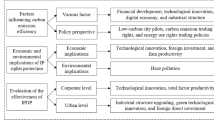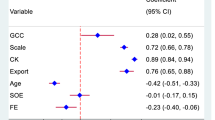Pengfei Cheng,
Yuhao Wang &
Mengzhen Wang
Humanities and Social Sciences Communications volume 11, Article number: 1233 (2024) Cite this article
Open access
Published: 17 September 2024
Abstract
Our study examines the relationship between intellectual property rights protection (IPRP) and carbon emissions (CE) using an unbalanced panel data set from 116 countries spanning 2008–2020. The analysis reveals a positive relationship between IPRP and CE. Mechanism tests and nonlinear analysis further elucidate this relationship. The mediation effect results indicated that IPRP indirectly fostered CE growth by inhibiting energy structure’s improvement, demonstrating that IPRP exacerbated the dependence on traditional high-carbon energy sources, hindering the transition to cleaner, more efficient energy systems. The analysis also revealed that IPRP indirectly promoted the increase of CE by promoting technological progress and economic growth. The moderation effect results suggest that political stability could mitigate the positive impact of IPRP on CE. Furthermore, the analysis reveals an inverted U-shaped relationship between IPRP and CE, indicating that while IPRP promotes an increase in CE in the initial stages, its intensification suppresses CE growth beyond a turning point. Hence, our study provides new theoretical and empirical evidence to understand the complex relationship between IPRP and CE. It also offers policy recommendations for effectively integrating global carbon reduction efforts with intellectual property policies.
Similar content being viewed by others

The impact of intellectual property demonstration policies on carbon emission efficiency
Article Open access03 July 2024

Do innovation and renewable energy transition play their role in environmental sustainability in Western Europe?
Article Open access02 January 2024

The inferiors imitate the superiors: the government’s low-carbon concerns and the renewable energy technology of firms
Article Open access27 February 2024
Introduction
In the face of increasingly severe environmental challenges today, particularly issues related to global warming and glacier melting, scholars have extensively explored methods to reduce carbon emissions (CE) to promote sustainable development. A substantial body of research suggests that improving energy structure (ES) and technological progress (TP) are crucial pathways to achieving carbon reduction (Li and Lin 2017). As a key factor influencing innovation and social development, intellectual property rights protection (IPRP) is also an indispensable part of the global economy (Zhu et al. 2022). However, over the past few decades, many countries have faced varying degrees of intellectual property infringement issues (Brander et al. 2017). With the international community’s collective efforts to reduce CE continuously strengthening, gaining a deeper understanding of the impact and mechanisms of IPRP on CE is of paramount importance for achieving global decarbonization goals.
Most existing studies focus on the innovation or growth impacts of IPRP. These studies illustrate that IPRP grants patent holders the right to control the knowledge they produce, thereby generating returns to fuel further research and development (R&D) investments. It also protects cutting-edge technology firms, enabling them to capture markets and earn substantial profits, ultimately fostering economic growth (Stiglitz 2017). Conversely, Auriol et al. (2023), Goldberg and Pavcnik (2007), and Madsen et al. (2010) argue that innovation and economic growth driven by “imitation” dominate in most developing countries. An excessive level of IPRP would restrict their ability to “imitate”, thereby impeding TP and economic growth.
However, the environmental impact of IPRP, particularly its effects on CE, has received little attention, despite being an important issue worldwide. Qian et al. (2023) regard China’s national intellectual property demonstration city policy as a quasi-natural experiment in intellectual property system construction and employ the differences-in-differences method to examine the impact of IPRP on CE. They find that the carbon reduction effect of IPRP is more pronounced in lower administrative level cities, small and medium-sized cities, and cities in western China. Yang et al. (2022), using a spatial econometric perspective and empirical evidence from a panel of Chinese cities, show that the spatial coordination of IPRP contributes to reducing CE. Similarly, Oyebanji et al. (2022), focusing on Spain, find that IPRP promotes the development of environmentally friendly technologies while reducing CE emissions.
Obviously, most studies are focused on specific countries or regions, lacking a global perspective, and there is no consensus that innovation, as a result of increased levels of intellectual property protection, can effectively reduce CE. In other words, the mechanism by which IPRP affects CE remains unclear. In addition, these studies often fail to fully consider the impact of other economic and political environmental factors, such as a stable political environment, as well as the nonlinear relationship between IPRP and CE.
Our study contributes to the existing literature in the following ways. First, we assess the impact of IPRP on CE by adopting a global perspective, which helps to evaluate the influence of IPRP on the worldwide environment more accurately. By using unbalanced panel data from 116 countries between 2008 and 2020, we find that an increase in the level of IPRP leads to an increase in CE, which challenges the traditional notion that IPRP unconditionally promotes environmental sustainability. Second, our results reveal the mechanism by which IPRP affects CE, providing a new perspective for policy formulation. Specifically, IPRP indirectly promotes CE growth by inhibiting ES improvement. On the contrary, IPRP may steer TP toward profitability rather than environmental sustainability, eventually increasing CE. Additionally, IPRP indirectly promotes the increase of CE by stimulating economic growth (EG). We also explore the moderating effect of political stability (PS) on the relationship between IPRP and CE. Finally, we find an inverted U-shaped relationship between IPRP and CE, indicating that the impact of IPRP on CE turns from positive to negative after reaching a certain threshold, highlighting the complexity and dual effects of IPRP. This finding significantly adds to the existing literature.
Yuhao Wang &
Mengzhen Wang
Humanities and Social Sciences Communications volume 11, Article number: 1233 (2024) Cite this article
Open access
Published: 17 September 2024
Abstract
Our study examines the relationship between intellectual property rights protection (IPRP) and carbon emissions (CE) using an unbalanced panel data set from 116 countries spanning 2008–2020. The analysis reveals a positive relationship between IPRP and CE. Mechanism tests and nonlinear analysis further elucidate this relationship. The mediation effect results indicated that IPRP indirectly fostered CE growth by inhibiting energy structure’s improvement, demonstrating that IPRP exacerbated the dependence on traditional high-carbon energy sources, hindering the transition to cleaner, more efficient energy systems. The analysis also revealed that IPRP indirectly promoted the increase of CE by promoting technological progress and economic growth. The moderation effect results suggest that political stability could mitigate the positive impact of IPRP on CE. Furthermore, the analysis reveals an inverted U-shaped relationship between IPRP and CE, indicating that while IPRP promotes an increase in CE in the initial stages, its intensification suppresses CE growth beyond a turning point. Hence, our study provides new theoretical and empirical evidence to understand the complex relationship between IPRP and CE. It also offers policy recommendations for effectively integrating global carbon reduction efforts with intellectual property policies.
Similar content being viewed by others

The impact of intellectual property demonstration policies on carbon emission efficiency
Article Open access03 July 2024

Do innovation and renewable energy transition play their role in environmental sustainability in Western Europe?
Article Open access02 January 2024

The inferiors imitate the superiors: the government’s low-carbon concerns and the renewable energy technology of firms
Article Open access27 February 2024
Introduction
In the face of increasingly severe environmental challenges today, particularly issues related to global warming and glacier melting, scholars have extensively explored methods to reduce carbon emissions (CE) to promote sustainable development. A substantial body of research suggests that improving energy structure (ES) and technological progress (TP) are crucial pathways to achieving carbon reduction (Li and Lin 2017). As a key factor influencing innovation and social development, intellectual property rights protection (IPRP) is also an indispensable part of the global economy (Zhu et al. 2022). However, over the past few decades, many countries have faced varying degrees of intellectual property infringement issues (Brander et al. 2017). With the international community’s collective efforts to reduce CE continuously strengthening, gaining a deeper understanding of the impact and mechanisms of IPRP on CE is of paramount importance for achieving global decarbonization goals.
Most existing studies focus on the innovation or growth impacts of IPRP. These studies illustrate that IPRP grants patent holders the right to control the knowledge they produce, thereby generating returns to fuel further research and development (R&D) investments. It also protects cutting-edge technology firms, enabling them to capture markets and earn substantial profits, ultimately fostering economic growth (Stiglitz 2017). Conversely, Auriol et al. (2023), Goldberg and Pavcnik (2007), and Madsen et al. (2010) argue that innovation and economic growth driven by “imitation” dominate in most developing countries. An excessive level of IPRP would restrict their ability to “imitate”, thereby impeding TP and economic growth.
However, the environmental impact of IPRP, particularly its effects on CE, has received little attention, despite being an important issue worldwide. Qian et al. (2023) regard China’s national intellectual property demonstration city policy as a quasi-natural experiment in intellectual property system construction and employ the differences-in-differences method to examine the impact of IPRP on CE. They find that the carbon reduction effect of IPRP is more pronounced in lower administrative level cities, small and medium-sized cities, and cities in western China. Yang et al. (2022), using a spatial econometric perspective and empirical evidence from a panel of Chinese cities, show that the spatial coordination of IPRP contributes to reducing CE. Similarly, Oyebanji et al. (2022), focusing on Spain, find that IPRP promotes the development of environmentally friendly technologies while reducing CE emissions.
Obviously, most studies are focused on specific countries or regions, lacking a global perspective, and there is no consensus that innovation, as a result of increased levels of intellectual property protection, can effectively reduce CE. In other words, the mechanism by which IPRP affects CE remains unclear. In addition, these studies often fail to fully consider the impact of other economic and political environmental factors, such as a stable political environment, as well as the nonlinear relationship between IPRP and CE.
Our study contributes to the existing literature in the following ways. First, we assess the impact of IPRP on CE by adopting a global perspective, which helps to evaluate the influence of IPRP on the worldwide environment more accurately. By using unbalanced panel data from 116 countries between 2008 and 2020, we find that an increase in the level of IPRP leads to an increase in CE, which challenges the traditional notion that IPRP unconditionally promotes environmental sustainability. Second, our results reveal the mechanism by which IPRP affects CE, providing a new perspective for policy formulation. Specifically, IPRP indirectly promotes CE growth by inhibiting ES improvement. On the contrary, IPRP may steer TP toward profitability rather than environmental sustainability, eventually increasing CE. Additionally, IPRP indirectly promotes the increase of CE by stimulating economic growth (EG). We also explore the moderating effect of political stability (PS) on the relationship between IPRP and CE. Finally, we find an inverted U-shaped relationship between IPRP and CE, indicating that the impact of IPRP on CE turns from positive to negative after reaching a certain threshold, highlighting the complexity and dual effects of IPRP. This finding significantly adds to the existing literature.
READ ON/DOWNLOAD PDF
No comments:
Post a Comment